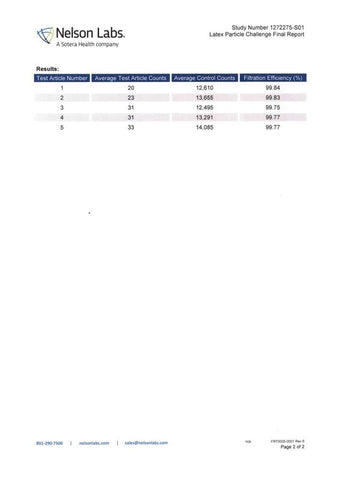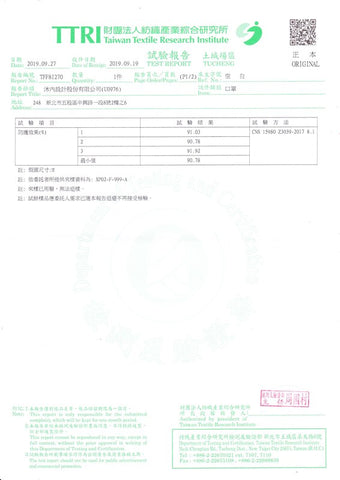Xpure Inside G3 related inspection reports:
CNS15980 Anti-haze (PM2.5) mask national standard test report (TTRI)
(8.1, 8.2.1, 8.3, 8.4, 8.8, 8.9)
(8.1, 8.2.1, 8.3, 8.4, 8.8, 8.9)
→ Passed CNS15980 level A (the highest level regardless of whether it is new or old)
→ The protective effect (test on human head, the most stringent item) reaches 93.89%! (Class A standard is 90%)
→ The particulate matter filtration efficiency (8.2.1, similar test method to N95) is 99.63% for PM0.3 salt spray and 99.39% for PM0.3 oil mist.
→ Respiratory impedance, earband fastness, free formaldehyde, PH value...etc. all passed certification standards.
→ The protective effect (test on human head, the most stringent item) reaches 93.89%! (Class A standard is 90%)
→ The particulate matter filtration efficiency (8.2.1, similar test method to N95) is 99.63% for PM0.3 salt spray and 99.39% for PM0.3 oil mist.
→ Respiratory impedance, earband fastness, free formaldehyde, PH value...etc. all passed certification standards.
 |
 |
KN95 (GB2626-2019) self-priming filtering anti-particulate respirator test report
(5.3 - Particle filter efficiency)
(5.3 - Particle filter efficiency)
→ The PM0.3 salt spray filtration efficiency of the three tested products is 99.403% / 99.597% / 98.851%, both of which are far greater than 95%!
 |
 |
 |
 |
CNS14774 National Standard Test Report (TTRI) for General Medical and Surgical Face Masks (TTRI)
(9.1-CNS14776, 9.2-CNS14775, 9.3-ASTM F2299-2017, 9.4-CNS14777, 9.5-CNS10285)
(9.1-CNS14776, 9.2-CNS14775, 9.3-ASTM F2299-2017, 9.4-CNS14777, 9.5-CNS10285)
→ Synthetic blood penetration, no penetration up to 160mmHg (Level 3 surgical mask standard). Much higher than the water repellency of ordinary medical masks
→ The average air exchange pressure difference is 5.1, which is slightly higher than the standard of 5.0 by 0.1
→ Particle filtration efficiency (0.1um PSL) reaches 99.98%! Much higher than the 98% required for level 3 surgical masks → Bacterial filtration efficiency (Staphylococcus aureus) > 99.9%! It is also much higher than the 98% requirement for level 3 surgical masks.
→ The average air exchange pressure difference is 5.1, which is slightly higher than the standard of 5.0 by 0.1
→ Particle filtration efficiency (0.1um PSL) reaches 99.98%! Much higher than the 98% required for level 3 surgical masks → Bacterial filtration efficiency (Staphylococcus aureus) > 99.9%! It is also much higher than the 98% requirement for level 3 surgical masks.
 |
 |
 |
 |
American ASTM Medical Mask International General Standard Test Report (SGS)
→ All test items passed ASTM medical mask standard level 3 (the highest level)
→ ASTM F2101:2019 Bacterial Filtration Efficiency (BFE) > 99.9%
→ EN 14683:2019 Air exchange pressure difference (breathing resistance) only 3.53 (standard is below 5)
→ ASTM F1862 blood penetration, no penetration up to 160mmHg measured
→ 16CFR Part 1610 flammability test, all passed → ASTM F2299:2017 Particle Filtration Efficiency (0.1um PSL) PFE > 99.96%
→ ASTM F2101:2019 Bacterial Filtration Efficiency (BFE) > 99.9%
→ EN 14683:2019 Air exchange pressure difference (breathing resistance) only 3.53 (standard is below 5)
→ ASTM F1862 blood penetration, no penetration up to 160mmHg measured
→ 16CFR Part 1610 flammability test, all passed → ASTM F2299:2017 Particle Filtration Efficiency (0.1um PSL) PFE > 99.96%
 |
 |
 |
 |
Filtration efficiency (TTRI) of FTTS-FP-157 with different particle sizes after 200 times of water washing
→ New product PM0.3 salt spray/oil mist filtration efficiency: 99.63% / 99.39%
→PM0.3 salt spray/oil mist filtration efficiency after 200 times of washing : 87.53% / 66.03%
→PM1.0 salt spray/oil mist filtration efficiency after 200 times of washing : 98.48% / 92.5%
→ Average salt spray/oil mist filtration efficiency after 200 times of washing : 94.11% / 82.38% (still greater than the 90% / 75% of the new CNS15980 B-level requirements, which means it still meets the anti-haze standard after 200 times of washing)
→PM0.3 salt spray/oil mist filtration efficiency after 200 times of washing : 87.53% / 66.03%
→PM1.0 salt spray/oil mist filtration efficiency after 200 times of washing : 98.48% / 92.5%
→ Average salt spray/oil mist filtration efficiency after 200 times of washing : 94.11% / 82.38% (still greater than the 90% / 75% of the new CNS15980 B-level requirements, which means it still meets the anti-haze standard after 200 times of washing)
 |
 |
Xpure Inside G2 related inspection reports:
ASTM filter material test report from Nelson Laboratory in the United States:
BFE (bacterial filtration efficiency) > 99.9%
 |
 |
VFE (Virus Filtration Efficiency) > 99.9%
 |
 |
PFE (Particle Filtration Efficiency) > 99.7%
 |
 |
Xpure Nano Protective Layer G2 - National Standard Test Report for Anti-Haze (PM2.5) Masks
(CNS15980 Grade B - 8.1, 8.2a, 8.2b, 8.4, 8.5, 8.6, 8.7, 8.8, 8.9)
(CNS15980 Grade B - 8.1, 8.2a, 8.2b, 8.4, 8.5, 8.6, 8.7, 8.8, 8.9)
→ The protective effect (air tightness test on human head) jumped from 69% of G1 to 88~91%!
→ The particulate matter filtration efficiency (8.2a, similar to N95 test method) is 95.8% for PM0.3 salt spray and 80.8% for PM0.3 oil mist.
→ The filtration efficiency (8.2b) of PM0.3 salt spray with different particle sizes is 95.4%, and PM0.3 oil mist is 90.6%.
→ "After 200 times of water washing", the filtration efficiency of PM0.3 salt spray is 80.6%, and PM0.3 oil mist is 69.1%.
→ Air density, ear strap fastness, color fastness, azo dyes, free formaldehyde, PH value, air valve cover fastness, etc. have all passed certification.
→ The particulate matter filtration efficiency (8.2a, similar to N95 test method) is 95.8% for PM0.3 salt spray and 80.8% for PM0.3 oil mist.
→ The filtration efficiency (8.2b) of PM0.3 salt spray with different particle sizes is 95.4%, and PM0.3 oil mist is 90.6%.
→ "After 200 times of water washing", the filtration efficiency of PM0.3 salt spray is 80.6%, and PM0.3 oil mist is 69.1%.
→ Air density, ear strap fastness, color fastness, azo dyes, free formaldehyde, PH value, air valve cover fastness, etc. have all passed certification.
8.1 Protection effect (dummy head air tightness test, using 0.3um oil mist, is the most stringent test)
 |
 |
8.2a sub-micron filtration efficiency (oil mist DEHS, salt mist NaCl), 8.3 inhalation impedance & exhalation impedance
8.4 Earband tensile strength, 8.6 color fastness to abrasion, 8.8 free formaldehyde content, 8.9 PH value
8.4 Earband tensile strength, 8.6 color fastness to abrasion, 8.8 free formaldehyde content, 8.9 PH value
 |
 |
8.2b Oil mist/salt mist filtration efficiency of different particle sizes-new product
 |
 |
8.2b Oil mist/salt mist filtration efficiency of different particle sizes - 200 times of water washing
 |
 |
8.5 Valve cover fastness → passed test
8.7 Azo dyes → None detected
8.7 Azo dyes → None detected
 |
 |
Xpure Nano Protective Layer G2 - CNS14755 Micron Filtration Efficiency Test Report
→ The test conditions are the same as those of the American NIOSH. The minimum salt spray filtration efficiency is 95.62%, which is in line with the international N95 level.
→ It is one of Taiwan’s N95 must pass standards. Only when the filtration efficiency reaches over 95% can it be declared as general N95 or medical N95.
(This test uses net convection filter material sheets for testing, which is different from N95, which uses complete masks for testing.)
→ It is one of Taiwan’s N95 must pass standards. Only when the filtration efficiency reaches over 95% can it be declared as general N95 or medical N95.
(This test uses net convection filter material sheets for testing, which is different from N95, which uses complete masks for testing.)
 |
 |
Xpure Nano Protective Layer G2 - CNS14775 (General Medical Mask) Bacterial Filtration Efficiency Test Report
→ The filtration efficiency of Staphylococcus aureus is >99.9%, which can basically be considered as no penetration of the bacterial liquid.
→ This item is one of the required test items for CNS14774 medical masks. If more than 95% of the test items are measured, it meets the medical mask standard.
→ This item is one of the required test items for CNS14774 medical masks. If more than 95% of the test items are measured, it meets the medical mask standard.

Xpure Inside G1 related inspection reports:
Xpure Nano Protective Layer G1 - National Standard Test Report for Anti-Haze (PM2.5) Masks
(CNS15980 Class D - 8.1, 8.2b, 8.4, 8.6, 8.7, 8.8, 8.9)
(CNS15980 Class D - 8.1, 8.2b, 8.4, 8.6, 8.7, 8.8, 8.9)
→ The average salt mist filtration efficiency is 96.51%; the average oil mist filtration efficiency is 83.15%. Respiratory impedance, air density, earband fastness, color fastness, dye safety... etc. all passed D-level standards.
   |
   |
Xpure Nano Protective Layer G1 (new product) inspection report (non-oily, FTTS-FP-157):
→ The filtration efficiency approaches 100% as the particle size increases: the filtration efficiency of PM0.2 is 84.35%, the efficiency of PM1.0 is 99.44%, and the efficiency of PM2.5 is 99.92%
 |
 |
Xpure nano protective layer G1 (washed 50 times) inspection report (non-oily, FTTS-FP-157) :
→ After washing 50 times, the PM0.2 filtration efficiency dropped to 65.56%, the PM1.0 efficiency dropped slightly to 95.86%, and the PM2.5 efficiency remained at 99.48%
 |
 |
Xpure Nano Protective Layer G1 (new product) inspection report (oily, EN779) :
→ For oil mist that is difficult to filter, net convection also performs well: PM0.2 filtration efficiency is 83.4%, PM1.0 efficiency is 99.82%, and PM2.5 efficiency is 100%
 |
 |
Xpure Nano Protective Layer G1 (New Product) Salt Spray Filtration Efficiency Test (0.26um / CNS14755):
→ Based on CNS14755 standard, the filtration efficiency of 0.26um [MMD] is 86.59%, and the respiratory impedance is 17.9 mmH2O

CNS14755 test report of Xpure Nano Protective Layer G1 (washed 200 times):
→ According to CNS14755 standard, after 200 times of washing, the filtration efficiency of 0.26um [MMD] is 60.72%, and the respiratory impedance is 15.0 mmH2O
 |
 |
Other inspection reports:
General mask and headscarf fabric inspection report (non-oily, FTTS-FP-157) :
→ Generally, the fabric of magic headscarf has almost no filtering function: PM0.2 filtration efficiency is 5.31%, PM1.0 efficiency is 35.82%, and PM2.5 efficiency is 57.23%
 |
 |
Anti-UV test report (UPF)
→ The product for testing in this report is a basic anti-haze mask, which contains Xpure nanometer protective layer G1.
→ UPF (Ultraviolet Protection Index) is greater than 500! (UPF above 50 is the highest level, which means the UV shielding rate of this product reaches 100%)
→ UPF (Ultraviolet Protection Index) is greater than 500! (UPF above 50 is the highest level, which means the UV shielding rate of this product reaches 100%)



